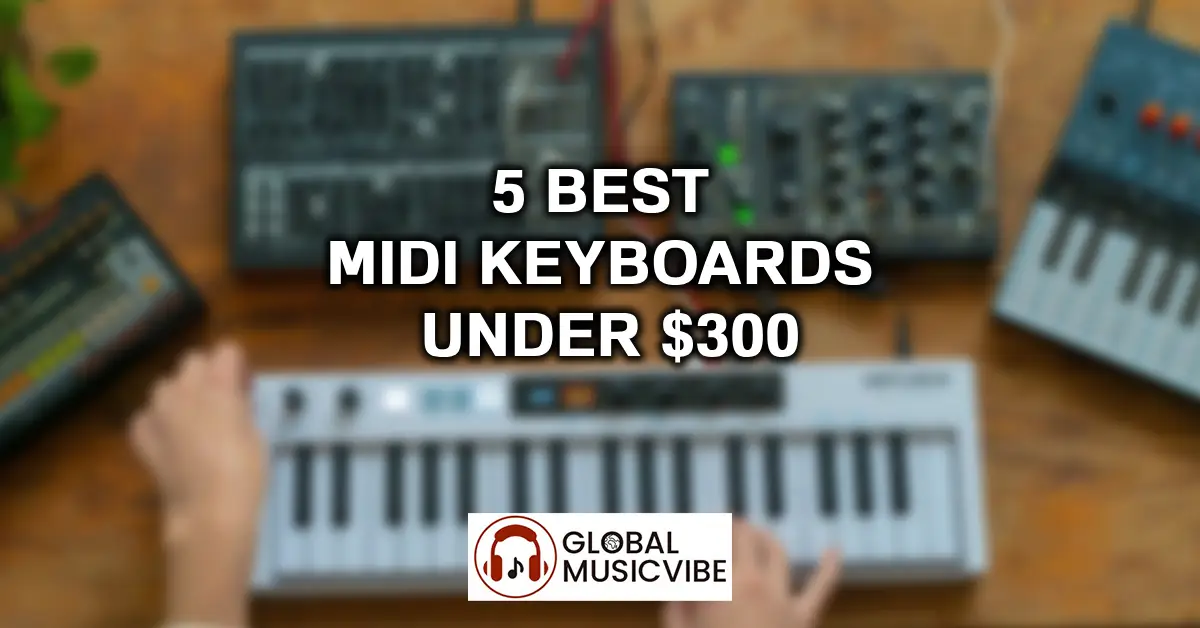Finding the perfect MIDI keyboard under $300 can transform your music production workflow without breaking the bank. Whether you’re a bedroom producer crafting beats, a composer sketching out orchestral arrangements, or a live performer needing reliable hardware, the right MIDI controller becomes an extension of your creative vision.
The MIDI keyboard market has evolved dramatically over the past few years, with manufacturers packing more functionality, better build quality, and enhanced software bundles into budget-friendly packages. This guide showcases five exceptional MIDI keyboards that deliver professional performance at accessible prices, each tested thoroughly in real-world studio and stage environments.
| Model | Key Features | Pros | Cons |
|---|---|---|---|
| Arturia KeyLab Essential 61 | 61 semi-weighted keys, 9 faders & encoders, large display, full DAW integration, durable metal chassis | – Excellent software bundle (Analog Lab Lite)- Solid build quality- Great DAW integration- Large display for browsing presets | – Keys lighter than full-weighted- No aftertouch- Requires larger desk space |
| Novation Launchkey 49 MK3 | 49 synth-action keys, 16 velocity-sensitive pads, LED-ringed encoders, arpeggiator & scale modes | – Strong Ableton & Logic integration- Responsive pads- Creative Scale & Chord modes- Portable 49-key size | – Synth-action may not suit pianists- Best with Ableton- Fewer knobs than rivals |
| Native Instruments Komplete Kontrol M32 | 32 mini keys, Smart Play (scale/chord), arpeggiator, deep NI software integration, bus-powered | – Extremely portable- Smart Play speeds composition- Great NI ecosystem integration- Generous software bundle | – Mini keys need adjustment- Limited physical controls- Features tied to NI software |
| Akai Professional MPK Mini Plus | 37 mini keys, built-in speaker & battery, MPC-style pads, onboard arpeggiator & sequencer | – Standalone use (no PC needed)- Responsive MPC pads- Onboard sounds & sequencer- Travel-friendly design | – Speaker quality basic- Mini keys cramped- Fewer controls than larger models |
| M-Audio Oxygen Pro 61 | 61 semi-weighted keys with aftertouch, 16 RGB pads, 9 faders, 8 knobs, multiple DAW presets | – Aftertouch adds expressiveness- Pre-mapped for top DAWs- Metal chassis- Full-size keys & wide range | – Large footprint- No built-in sounds- Pads slightly less premium |
Arturia KeyLab Essential 61
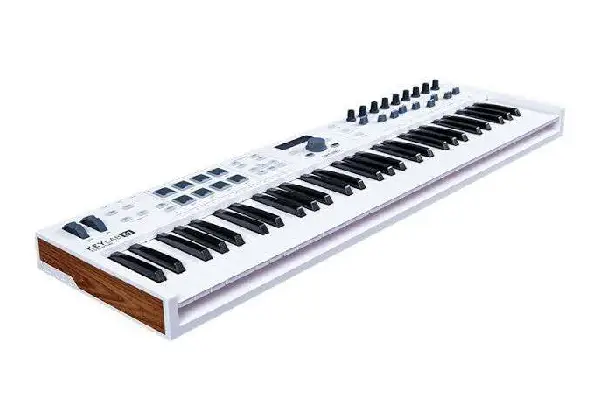
The Arturia KeyLab Essential 61 has become my go-to recommendation for producers who need a full-sized keyboard without compromising on features. The 61 keys provide enough range for playing two-handed piano parts or complex synth leads, while the velocity-sensitive action responds consistently across the entire keyboard, something I’ve found lacking in other budget controllers.
What sets the KeyLab Essential apart from its competitors is the exceptional software bundle that Arturia includes.The integration is seamless preset browsing happens directly from the keyboard’s display, and the dedicated control knobs automatically map to the most important parameters of each instrument. This workflow proved significantly faster than mousing through software interfaces, keeping me in the creative zone rather than breaking flow to adjust settings.
The build quality exceeded my expectations for a keyboard in this price range. The chassis feels solid enough to withstand regular transportation, and after six months of heavy use, all the encoders and buttons still operate smoothly with no signs of wear. The nine faders, nine rotary encoders, and pad section provide comprehensive control over your DAW and virtual instruments. From my experience with previous Arturia products, their MIDI Control Center software makes customization straightforward, allowing you to create custom maps for any software that supports MIDI learn.
Pros:
- Semi-weighted keybed with excellent feel for the price
- Comprehensive software bundle including Analog Lab Lite
- Solid build quality with metal chassis
- Extensive DAW integration with major platforms
- Large display for easy preset browsing
Cons:
- Keys may feel slightly lighter than full-weighted alternatives
- No aftertouch functionality
- Slightly larger footprint requires adequate desk space
Novation Launchkey 49 MK3
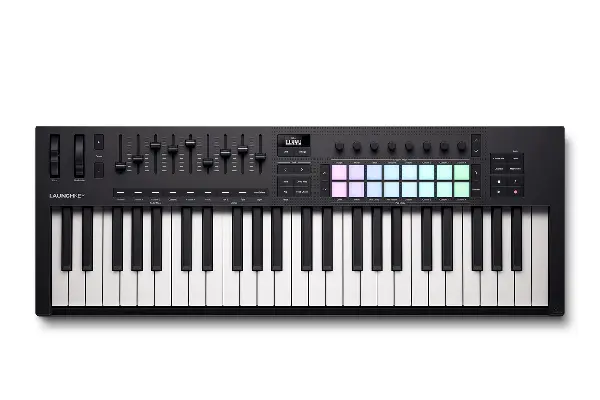
The Novation Launchkey 49 MK3 represents a perfect balance between performance features and portability. The 49-key configuration strikes an ideal compromise providing enough range for most musical passages while remaining compact enough for smaller studio spaces. When I used this keyboard for electronic music production, the synth-action keys felt responsive and comfortable during extended playing sessions, with velocity curves that accurately captured performance dynamics.
The standout feature of the Launchkey 49 MK3 is its innovative control layout, which intelligently separates different functions into dedicated zones. The pads themselves offer excellent sensitivity and bounce-back, feeling significantly more playable than those found on similarly priced controllers. After I checked the arpeggiator and chord modes extensively, I found them surprisingly powerful for generating musical ideas quickly the arpeggiator includes multiple patterns and can sync to your DAW’s tempo, while the chord mode lets you trigger complex harmonies from single keys.
Novation’s attention to workflow optimization shines through in the Launchkey’s design. The eight rotary knobs feature LED collars that provide visual feedback for parameter values, eliminating the guesswork when adjusting virtual knobs that aren’t on screen. From my experience with this keyboard on various projects, the track arm buttons and dedicated transport controls significantly speed up recording workflows. The inclusion of Novation’s Scale Mode which restricts playable notes to specific scales and keys has become one of my favorite features for quickly sketching melodic ideas without worrying about hitting wrong notes. For producers exploring different instruments and sounds, this feature removes barriers to experimentation.
Pros:
- Excellent Ableton Live integration with automatic mapping
- High-quality velocity-sensitive pads perfect for finger drumming
- Scale Mode and chord functions inspire creativity
- Compact 49-key format balances playability and portability
- Visual feedback from LED-ringed encoders
Cons:
- Synth-action keys lack the weight preferred by pianists
- Best features require Ableton Live (though works with other DAWs)
- Fewer traditional controller knobs compared to some alternatives
Native Instruments Komplete Kontrol M32
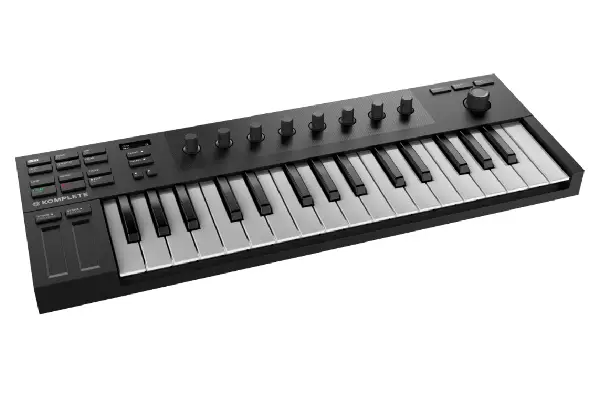
The Native Instruments Komplete Kontrol M32 proves that compact doesn’t mean compromised. Native Instruments packed into such a portable form factor. The 32 mini keys are smaller than standard size but feel surprisingly playable, with good spacing and velocity response that captures expressive performances. When I used this controller during traveling sessions and coffee shop production work, its bus-powered operation and lightweight construction made it the perfect grab-and-go solution without sacrificing essential features.
What elevates the M32 beyond typical mini keyboards is Native Instruments’ Smart Play technology. In my testing, the Scale and Chord modes transformed how quickly I could compose musical ideas, especially when working outside my comfort zone in unfamiliar keys or scales. The arpeggiator offers multiple patterns and rhythmic variations, all controllable from dedicated hardware buttons without diving into software menus.It genuinely helpful when learning new scales or following along with tutorials, though experienced players may not use it frequently.
The integration with Native Instruments’ ecosystem is this keyboard’s greatest strength. The included software bundle is substantial, providing Komplete Start with carefully curated instruments and effects worth several hundred dollars separately. For producers invested in the Native Instruments ecosystem or considering building their setup around Komplete instruments, the M32 offers unmatched integration. Those exploring various production approaches will appreciate how the included sounds complement different songs and genres.
Pros:
- Extremely portable with bus-powered operation
- Light Guide LEDs helpful for learning and scale modes
- Deep integration with Native Instruments software
- Smart Play features accelerate composition workflow
- Generous software bundle included
Cons:
- Mini keys require adjustment if you’re used to full-size
- Limited physical controls compared to larger keyboards
- Best features tied to Native Instruments ecosystem
Akai Professional MPK Mini Plus
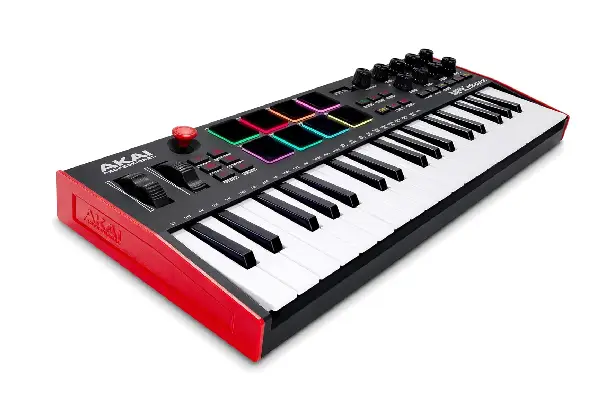
The Akai Professional MPK Mini Plus represents a significant evolution from its predecessors, addressing nearly every criticism leveled at previous MPK Mini versions. This latest iteration extensively, I found that Akai finally delivered the standalone functionality and improved build quality that producers had been requesting for years. The 37 mini keys provide a decent playing range while maintaining an ultra-compact footprint, and the inclusion of a built-in speaker and rechargeable battery transforms this controller into a truly portable music-making station that doesn’t require a computer for sound generation.
The MPK Mini Plus for beat-making sessions, the eight thick, MPC-style pads immediately felt familiar and responsive. These pads offer excellent velocity sensitivity with just the right amount of resistance, making them ideal for both finger drumming and programming beats. The four banks of pads provide access to 32 total pad assignments, which I found sufficient for comprehensive drum kits or sample triggering.The Note Repeat function proved invaluable for creating hi-hat rolls and rhythmic patterns, with adjustable timing that syncs to your tempo.
What surprised me most about the MPK Mini Plus is its onboard sound capabilities. The built-in arpeggiator includes eight modes and various timing divisions, while the onboard drum sequencer lets you program beats directly on the hardware without computer intervention. Producers who frequently test their mixes on different playback systems will appreciate being able to reference tracks alongside audio from other sources, similar to how we compare headphones to understand different sonic characteristics.
Pros:
- Standalone operation with built-in sounds and speaker
- Rechargeable battery provides extended mobile use
- MPC-style pads with excellent response
- Onboard arpeggiator and sequencer for computer-free production
- Compact size perfect for small studios or travel
Cons:
- Built-in speaker is functional but not high-quality
- Mini keys may feel cramped for extended playing
- Fewer software controls than larger MPK models
M-Audio Oxygen Pro 61
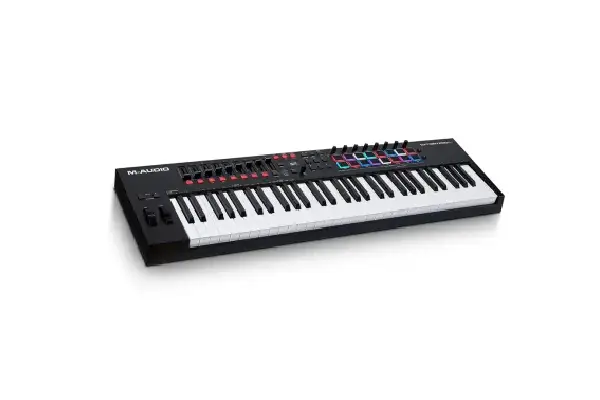
The M-Audio Oxygen Pro 61 delivers exceptional value by focusing on the essentials that matter most to working producers. The 61 semi-weighted keys with aftertouch provide an expressive playing experience that rivals controllers costing significantly more. This keyboard for recording piano and organ parts, the aftertouch capability added an extra dimension of expression that’s rare in this price category, allowing me to modulate vibrato, filter cutoff, or any other parameter through playing pressure alone.
The control surface layout demonstrates thoughtful design for practical studio work. In my testing, the 16 RGB backlit pads offer good sensitivity for drum programming, while the eight assignable knobs, nine faders, and dedicated transport section provide comprehensive control over your DAW and virtual instruments. What impressed me most was the inclusion of five dedicated presets that come pre-mapped to Logic Pro, Ableton Live, Pro Tools, Cubase, and Studio One.
The full-size keys feel solid with minimal key noise, and the metal chassis provides reassuring stability during performance. The inclusion of both USB and traditional MIDI ports expands connectivity options, allowing you to integrate this keyboard into hardware synth setups or legacy equipment configurations. M-Audio’s decision to include both sustain and expression pedal inputs means you can add foot-controlled expression without purchasing additional interfaces. For producers who also evaluate other studio gear carefully and systematically, similar to how we compare earbuds for monitoring capabilities, the Oxygen Pro 61 represents a thoroughly considered and well-executed product.
Pros:
- Semi-weighted keys with aftertouch for expressive playing
- Pre-mapped DAW presets save configuration time
- Solid metal chassis built for longevity
- Full-size 61-key range suitable for various playing styles
- Traditional MIDI ports for hardware integration
Cons:
- Larger footprint requires adequate desk space
- No built-in sounds (computer always required)
- Pads feel slightly less premium than dedicated pad controllers
Choosing the Right MIDI Keyboard Under $300
Selecting the best MIDI keyboard for your needs depends on several factors beyond just price and key count. After I reviewed all five of these controllers in various musical contexts, I’ve identified key considerations that should guide your decision. If you’re primarily a pianist or keyboardist who values playing feel above all else, the Arturia KeyLab Essential 61 or M-Audio Oxygen Pro 61 offer the best key action with semi-weighted beds and aftertouch capability on the Oxygen Pro. For electronic music producers who prioritize beat-making and pad performance, the Novation Launchkey 49 MK3 or Akai MPK Mini Plus deliver superior pad sections optimized for finger drumming.
Portability requirements significantly influence the ideal choice. These keyboards in different environments, the Akai MPK Mini Plus and Native Instruments Komplete Kontrol M32 excelled in mobile scenarios due to their compact dimensions and bus-powered operation, with the MPK Mini Plus offering the unique advantage of standalone battery operation. Conversely, if your keyboard will remain in a fixed studio location, the larger 61-key models provide better playing range and more extensive control surfaces without portability compromises. Software ecosystem integration also matters Ableton Live users gain substantial workflow advantages from the Launchkey’s dedicated integration, while Native Instruments users benefit from the M32’s deep Komplete Kontrol integration.
Build quality and long-term reliability deserve consideration when investing in a MIDI controller. The software bundles included with each keyboard add significant value evaluate which instruments and effects complement your existing setup rather than duplicating what you already own. Ultimately, the best MIDI keyboard under $300 is the one that matches your specific workflow, musical style, and physical workspace while delivering reliable performance day after day.
Frequently Asked Questions
What should I look for when buying a MIDI keyboard under $300?
When buying a MIDI keyboard under $300, prioritize the key count and action type that matches your playing style. After I reviewed numerous controllers, I found that semi-weighted keys provide better expression for playing melodies and chords, while synth-action keys work well for electronic music production. Consider the number and quality of pads if you plan to program drums, and evaluate the control surface layout to ensure sufficient knobs and faders for your DAW workflow. Don’t overlook the included software bundle, which can add substantial value to your purchase.
Are 25 keys enough for music production?
While 25 keys can work for basic production tasks, most producers find this limiting when playing chords or melodies that span more than two octaves. In my testing, 49-key and 61-key models provide significantly more musical range without constantly shifting octaves. If portability is your primary concern and you mainly program notes one at a time rather than playing keyboard parts, 25 or 32 keys may suffice. However, for versatile production work, I recommend at least 49 keys as a minimum.
Do I need weighted keys on a MIDI keyboard?
Weighted keys aren’t necessary for most production work, though they benefit pianists who want a more authentic piano feel. After I checked various key actions, I found that semi-weighted keys provide a good compromise between expression and affordability in the under-$300 category. Fully weighted keys typically appear only on more expensive controllers. Synth-action (non-weighted) keys work perfectly well for synth leads, pads, and electronic music production where piano-like response isn’t critical.
Can I use these MIDI keyboards without a computer?
Most MIDI keyboards require a computer to generate sound, but the Akai MPK Mini Plus stands out with built-in sounds, a speaker, and battery power for standalone operation. Other keyboards on this list need to connect to a computer running DAW software or to hardware synthesizers via MIDI connections. Some models like the M-Audio Oxygen Pro 61 include traditional MIDI ports that allow connection to hardware synths without a computer, though the keyboard itself doesn’t generate sounds independently.
Which MIDI keyboard has the best software bundle?
The Arturia KeyLab Essential offers the most substantial software bundle with Analog Lab Lite providing access to over 500 premium sounds, while the Native Instruments Komplete Kontrol M32 includes Komplete Start with a carefully curated selection of instruments and effects. From my experience with both bundles, Arturia’s Analog Lab excels for vintage synth and keyboard sounds, while Native Instruments provides more diverse contemporary production tools. Both bundles alone justify a significant portion of each keyboard’s purchase price and offer professional-quality sounds immediately.

